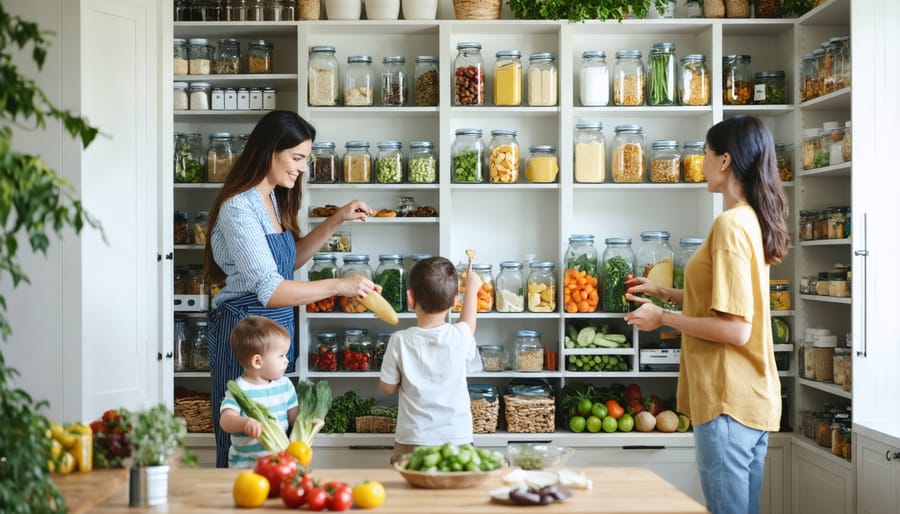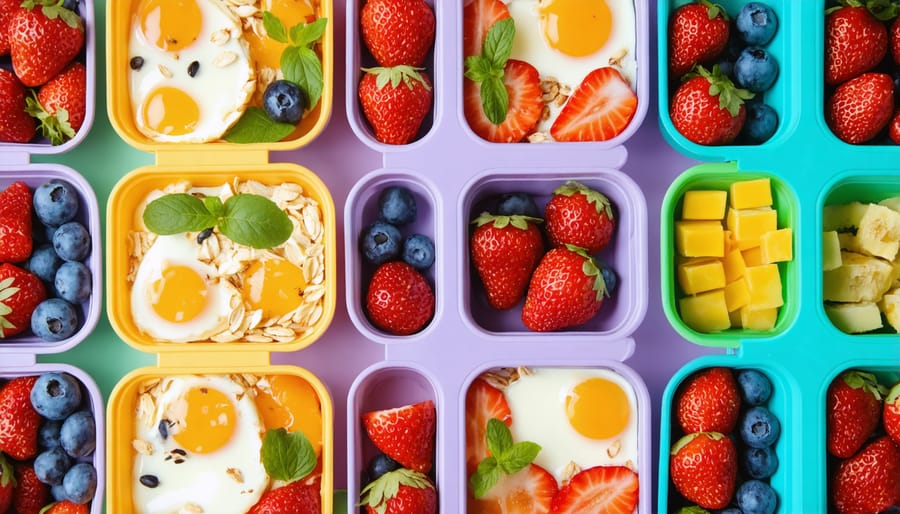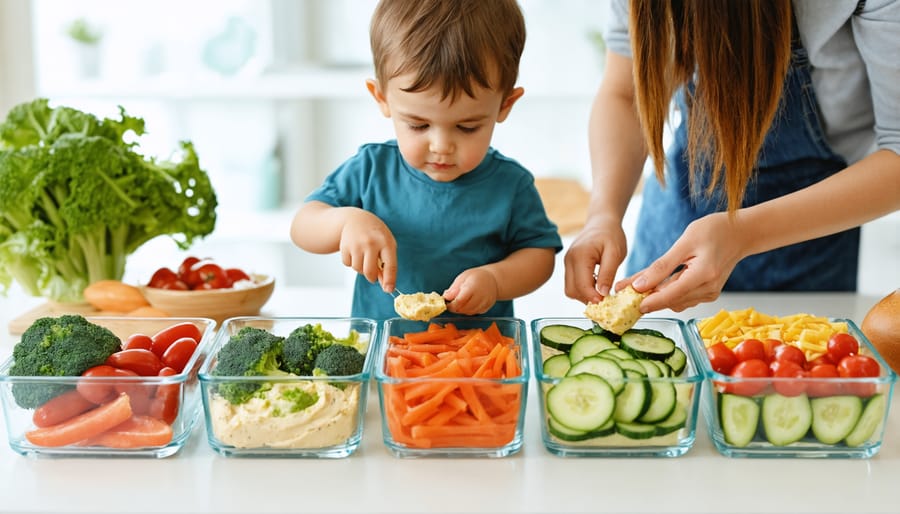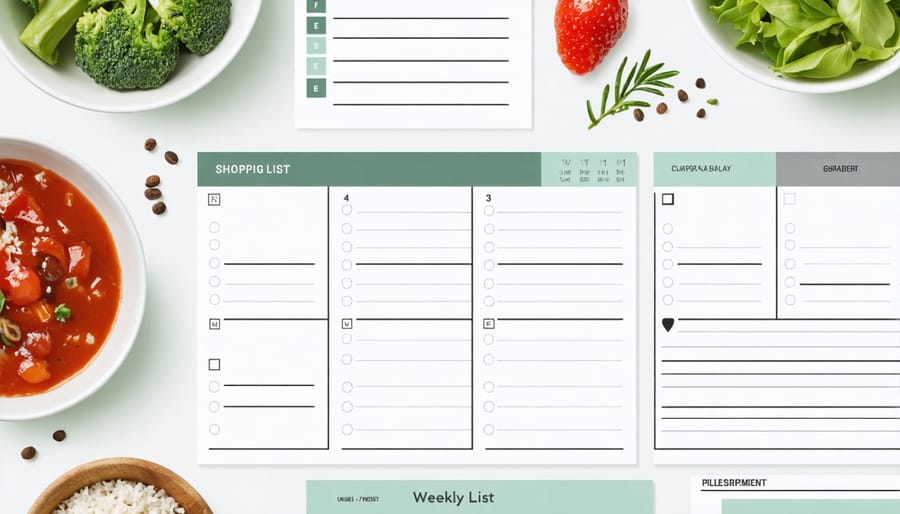
Transform your family’s eating habits with a structured 6-week roadmap that makes healthy eating simple, sustainable, and enjoyable. This comprehensive plan breaks down the overwhelming task of nutritional change into manageable weekly goals, leading to lasting meal planning success. As a mom who’s guided hundreds of families through this transition, I’ve designed each week to build upon the previous one, creating a foundation of healthy habits that stick.
Start by mastering breakfast in week one, then progress through lunch, dinner, and snacks in subsequent weeks. Week five focuses on mindful eating techniques, while the final week brings everything together with batch cooking and strategic meal prep. This approach eliminates the all-or-nothing mindset that often derails nutrition goals, replacing it with practical, family-friendly strategies that work in real life.
No more confused wandering through grocery aisles or last-minute takeout decisions. Whether you’re juggling picky eaters, busy schedules, or budget constraints, this plan adapts to your family’s unique needs while steadily moving you toward better nutrition choices. Let’s create lasting change, one delicious meal at a time.
Setting Your Family Up for Success
Kitchen Clean-Out and Restocking
Let’s kick off your healthy eating journey with a kitchen makeover that sets you up for success! As someone who’s helped countless families transition to clean eating for families, I can tell you that this first step is crucial.
Start by removing items that don’t align with your health goals. Those half-empty bags of chips hiding in the back of your pantry? Time to say goodbye! Don’t feel guilty about clearing out processed foods – think of it as making space for nourishing alternatives.
Next, organize your kitchen into zones. Create a smoothie station with your blender and healthy add-ins, set up a snack drawer filled with nuts and dried fruits, and designate a meal prep area with easy access to cutting boards and storage containers.
When restocking, focus on whole foods: colorful fruits and vegetables, lean proteins, whole grains, and healthy fats. Stock up on versatile basics like quinoa, olive oil, herbs, and spices. Remember, a well-organized kitchen with healthy options readily available makes it easier to stick to your new eating habits.
Pro tip: Take a photo of your newly organized space – it’s amazing how motivating a before-and-after comparison can be!

Getting the Whole Family On Board
Transitioning to healthier eating habits is much easier when everyone in the household is on the same page. Start by implementing effective family communication strategies to discuss the upcoming changes openly and positively. Make it fun by involving children in meal planning and grocery shopping – let them choose new fruits and vegetables to try each week.
Create a colorful chart where family members can place stickers for trying new healthy foods or helping with meal prep. Turn cooking into family time by assigning age-appropriate tasks to everyone. Even toddlers can help wash vegetables or tear lettuce leaves! For reluctant partners or picky eaters, start with small changes and celebrate victories together.
Remember, this journey isn’t about restriction – it’s about creating lasting healthy habits together. Keep familiar favorites in rotation while gradually introducing healthier versions of beloved dishes. When children see parents enjoying nutritious foods, they’re more likely to follow suit. Make mealtimes a positive, screen-free zone where you can connect and share stories while enjoying wholesome food together.
Week-by-Week Breakdown
Week 1: Building Better Breakfast Habits
Let’s kick off our healthy eating journey where it all begins – breakfast! I used to be a chronic breakfast-skipper myself, rushing out the door with just coffee in hand. But transforming my morning routine has been a game-changer for my energy levels and overall health.
This week, we’ll focus on building sustainable breakfast habits that work with your busy schedule. Start by setting your alarm just 15 minutes earlier – trust me, it’s worth it! Stock your kitchen with quick, nutritious options like overnight oats, whole-grain toast, and fresh fruits.
Here’s your week 1 action plan:
– Day 1-2: Choose one healthy breakfast and repeat it
– Day 3-4: Try a new breakfast recipe
– Day 5-7: Mix and match from your favorite options
Some foolproof breakfast ideas to get you started:
– Greek yogurt parfait with berries and honey
– Whole-grain toast with avocado and a hard-boiled egg
– Banana smoothie with spinach and nut butter
– Overnight oats with chia seeds and cinnamon
Remember, the goal isn’t perfection – it’s progress. If you slip back into old habits one morning, simply reset the next day. By the end of this week, you’ll notice more consistent energy levels and fewer mid-morning cravings.
Pro tip: Prep breakfast ingredients the night before. Even small steps like setting out your bowl and measuring dry ingredients can make the morning routine smoother.

Week 2: Lunch Box Makeover
Let’s revolutionize your lunch game! I remember when I first started packing healthier lunches – it felt overwhelming until I discovered some simple swaps that made all the difference. This week, we’re focusing on transforming your midday meal into a nourishing powerhouse that’ll keep you energized throughout the afternoon.
Start by investing in a compartmentalized lunch container – this makes portion control effortless and keeps foods separate and fresh. Replace white bread with whole grain options, or try wraps made with lettuce or collard greens. Instead of mayo-heavy sandwiches, experiment with hummus, mashed avocado, or Greek yogurt-based spreads.
Pack your lunch box with colorful vegetables – cherry tomatoes, cucumber slices, and baby carrots are perfect finger foods. For protein, think beyond deli meats: try hard-boiled eggs, chickpea salad, or leftover grilled chicken from dinner. Replace chips with air-popped popcorn, nuts, or roasted chickpeas for that satisfying crunch.
Make prep easier by planning ahead on Sunday. Wash and cut vegetables, portion out snacks, and prepare protein options for the week. For busy mornings, try the “pack-at-night” strategy – it’s a game-changer! Remember to include a reusable water bottle to stay hydrated throughout the day.
Pro tip: Keep emergency healthy snacks in your desk or bag for those extra-hungry days. A handful of almonds or a piece of fruit can prevent afternoon vending machine visits.
Week 3: Snack Smart
Let’s talk about transforming your snacking habits from mindless munching to mindful nourishment! As a mom who used to struggle with the 3 PM energy crash (hello, office vending machine!), I’ve learned that smart snacking can be a game-changer for the whole family.
Start by creating designated snack zones in your kitchen. Stock clear containers with ready-to-eat fruits, cut vegetables, and portion-controlled nuts. When healthy options are visible and accessible, they become the easy choice for everyone, especially kids.
Here’s your week 3 action plan: First, prep three types of snack boxes on Sunday – protein-rich options (like hard-boiled eggs or turkey roll-ups), fiber-filled choices (think apple slices with almond butter), and energy-boosting combinations (such as homemade trail mix). These grab-and-go options will save you from reaching for processed alternatives when hunger strikes.
Make snacking interactive and fun! Create a “snack artist” station where kids can build their own balanced plates. Think of it as a healthy canvas with colorful vegetables, whole grain crackers, and protein options. Not only does this encourage creativity, but it also teaches portion control naturally.
Remember, timing matters. Plan snacks for when energy typically dips – mid-morning and mid-afternoon. This strategy helps maintain stable blood sugar levels and prevents overeating at main meals. Stay hydrated too; sometimes thirst masquerades as hunger.

Week 4: Dinner Time Revolution
Let’s revolutionize your dinner routine with family-friendly meals that everyone will love! As a mom of two, I know the evening rush can feel overwhelming, but I’ve discovered that a well-planned dinner strategy can transform chaos into quality family time.
Start by creating a weekly dinner menu board – this simple step eliminates the dreaded “what’s for dinner?” question and helps you shop more efficiently. I recommend planning five flexible meals per week, leaving room for leftovers or occasional takeout.
Here are some crowd-pleasing dinner ideas that take 30 minutes or less:
– Sheet pan chicken fajitas with colorful bell peppers
– Build-your-own grain bowls with quinoa, roasted vegetables, and protein options
– One-pot pasta primavera loaded with seasonal vegetables
– Turkey and sweet potato skillet with fresh herbs
– Fish tacos with mango salsa and avocado
Pro tip: Prep vegetables and proteins on Sunday afternoon when things are typically calmer. Store them in clear containers at eye level in your fridge – this makes weeknight cooking so much smoother!
Get the kids involved by letting them choose one dinner each week and helping with age-appropriate tasks. My little ones love measuring ingredients and setting the table, which naturally builds their interest in healthy eating.
Remember, perfect is the enemy of good. Some nights might still be scrambled eggs and toast – and that’s perfectly okay! The goal is progress, not perfection, in creating healthier dinner habits that work for your unique family.
Week 5: Weekend Warrior Meal Prep
Welcome to the game-changing week where we master the art of meal prep! As a busy mom who used to scramble for healthy weeknight dinners, I’ve learned that dedicating a few hours on the weekend can transform your entire week. Let’s make meal prep your new Sunday self-care ritual!
Start by planning three main dishes that can be mixed and matched throughout the week. Think versatile proteins like grilled chicken breasts, roasted chickpeas, or baked salmon. While one dish is in the oven, prep your veggies – wash, chop, and store them in clear containers. Pro tip: roast a big batch of vegetables with olive oil and your favorite seasonings – they’ll stay fresh for days and can be added to any meal.
Make friends with your food processor for quick prep work, and don’t forget to cook a big batch of whole grains like quinoa or brown rice. Store them in portion-sized containers for easy grab-and-go lunches. I love preparing overnight oats in mason jars and cutting up fruit for morning smoothies – future you will be thankful!
Remember to label everything with dates and contents. Invest in good quality containers that stack well in your fridge. The key is to create a system that works for your lifestyle – start small with just a few prep tasks and gradually build up as you get more comfortable with the routine.
Week 6: Maintaining Momentum
Congratulations on making it to the final week! By now, you’ve established some amazing mindful family habits, and it’s time to focus on maintaining this wonderful momentum you’ve built. Remember, sustainability is key to long-term success.
Special occasions and social events don’t have to derail your progress. Instead of viewing them as obstacles, see them as opportunities to practice balance. When attending parties or dining out, try the 80/20 approach: make nutritious choices 80% of the time while allowing yourself to mindfully enjoy treats for the remaining 20%.
Create a weekly meal planning ritual that works for your schedule. I personally love Sunday afternoon planning sessions with a cup of tea, reviewing what worked well the previous week and brainstorming new recipes to try. Keep a collection of your family’s favorite healthy meals for busy weeks when inspiration runs low.
Listen to your body’s signals and adjust portions accordingly. Some days you might need more energy, while others require less. This intuitive approach helps maintain a healthy relationship with food while sustaining your new habits.
Remember, this journey isn’t about perfection – it’s about progress. Celebrate your achievements, whether big or small, and be proud of how far you’ve come. You’ve laid the groundwork for a healthier lifestyle that will benefit your entire family for years to come.
Shopping and Meal Planning Tools

Weekly Shopping Lists
Stocking your kitchen with the right ingredients is key to success on this 6-week journey. I remember how overwhelming it felt at first, but trust me, having these essentials on hand makes healthy eating so much easier!
Start with these pantry staples:
– Whole grains: quinoa, brown rice, oats, whole grain pasta
– Legumes: black beans, chickpeas, lentils
– Nuts and seeds: almonds, walnuts, chia seeds, flax seeds
– Healthy oils: extra virgin olive oil, avocado oil
– Seasonings: herbs, spices, apple cider vinegar, lemon juice
Fresh items to buy weekly:
– Leafy greens: spinach, kale, mixed salad greens
– Colorful vegetables: bell peppers, carrots, broccoli, sweet potatoes
– Fruits: berries, apples, citrus fruits, bananas
– Lean proteins: chicken breast, fish, tofu, eggs
– Dairy or alternatives: Greek yogurt, almond milk, cottage cheese
Pro tip: Keep frozen fruits and vegetables on hand for those busy weeks when you can’t shop as frequently. I always stock frozen berries, peas, and spinach – they’re perfect for quick smoothies and last-minute meal additions.
Remember, you don’t need to buy everything at once. Start with the basics and gradually build your healthy kitchen as you progress through the weeks. Many of my readers find it helpful to shop on Sundays to prepare for the week ahead.
Time-Saving Tips and Tricks
Let’s make healthy eating work with your busy schedule! As a mom who’s been on this journey, I’ve discovered that success lies in working smarter, not harder. The key to sustainable family living is establishing efficient routines that stick.
Start by dedicating two hours every weekend for meal prep. Wash and chop vegetables in bulk, portion ingredients, and prepare basic staples like quinoa or grilled chicken. Store these in clear containers at eye level in your fridge – you’re more likely to use what you can see!
My game-changing hack? The “cook once, eat twice” method. When making dinner, double the recipe and transform leftovers into tomorrow’s lunch. For instance, tonight’s roasted vegetables can become tomorrow’s colorful grain bowl.
Keep a running grocery list on your phone and order staples in bulk. Consider subscribing to a local produce delivery service – it saves time and ensures fresh ingredients are always on hand. For busy mornings, prepare overnight oats in mason jars or freeze smoothie ingredients in individual bags.
Don’t forget to involve the family! Turn meal prep into quality time by assigning age-appropriate tasks. My kids love being “kitchen helpers,” and it teaches them valuable life skills while making the process more enjoyable for everyone.
Remember, small time investments now lead to significant time savings later. These strategies have helped countless busy families maintain healthy eating habits without feeling overwhelmed.
Congratulations on taking this important step toward transforming your eating habits! Over these past six weeks, we’ve explored how small, sustainable changes can lead to significant improvements in your overall health and wellbeing. Remember, this journey isn’t about perfection – it’s about progress and creating lasting habits that work for your lifestyle.
As you’ve discovered, healthy eating doesn’t have to be complicated or restrictive. By focusing on meal planning, incorporating more whole foods, and being mindful of portion sizes, you’ve built a foundation for long-term success. The skills you’ve learned – from smart grocery shopping to meal prep strategies – will serve you well beyond these six weeks.
I’ve heard from so many readers who’ve shared their success stories, from having more energy to feeling more confident in their food choices. One reader, Sarah, mentioned how her whole family now looks forward to their weekly meal planning sessions, turning it into a fun bonding activity!
Remember, everyone’s journey is unique, and it’s okay to adapt these guidelines to fit your personal needs and preferences. The key is to keep moving forward, even if you face occasional setbacks. Start with what feels manageable, celebrate your victories (no matter how small), and be patient with yourself as you build these new habits.
Why not start today? Pick one strategy from the plan that resonates with you the most and implement it this week. Your future self will thank you for taking that first step toward a healthier, more energized you!
Stay connected with our community for ongoing support, recipe ideas, and success stories. Here’s to your continued success on this healthy eating journey!



